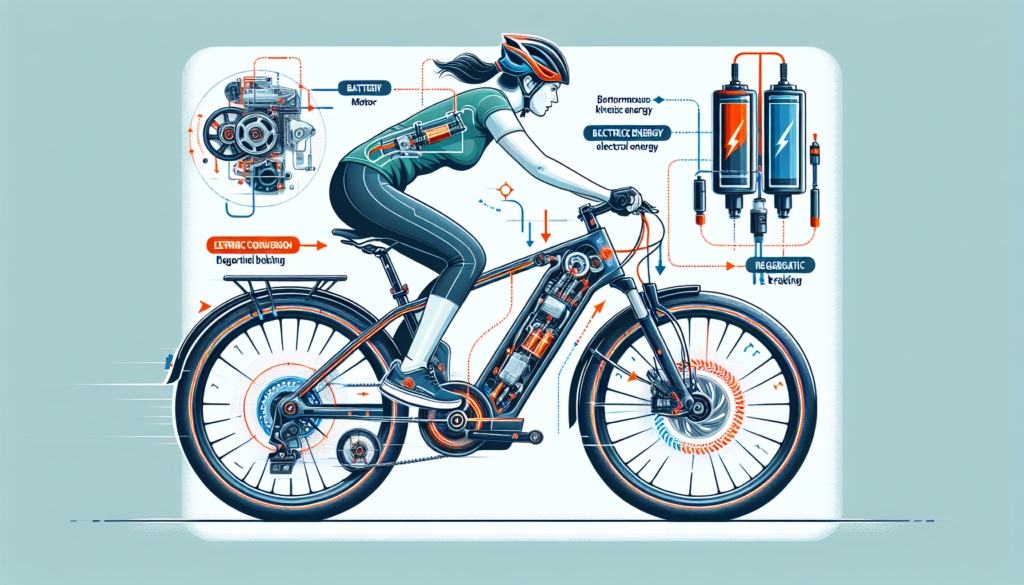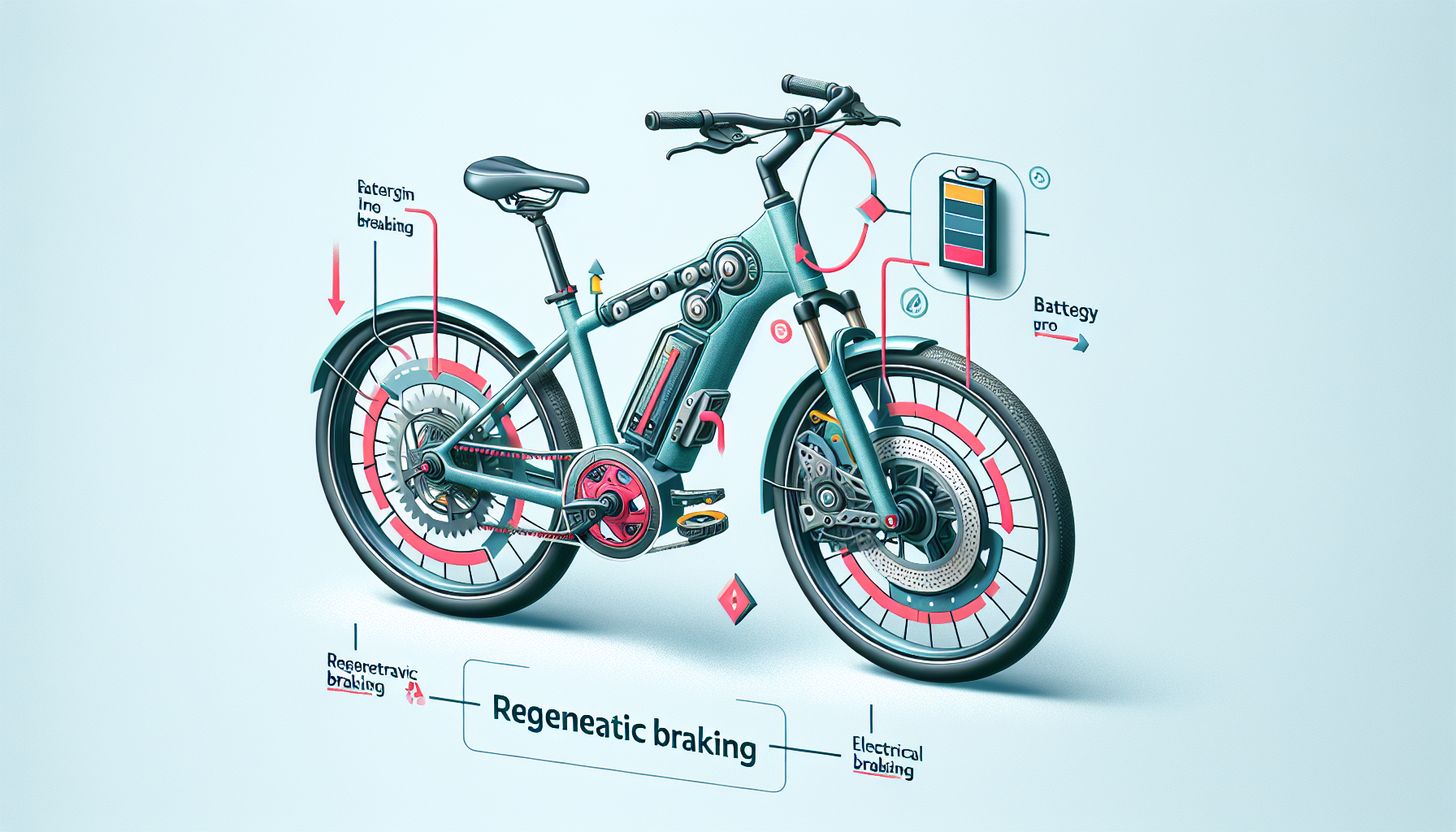Imagine cruising down a scenic bike path, feeling the wind in your hair and the sun on your face. As you pedal effortlessly, you start to wonder if e-bikes have regenerative braking. Can these electric-powered wonders harness and store energy while you brake? In this article, we’ll explore the fascinating world of e-bikes and their potential for regenerative braking. Get ready to discover the science behind this innovative technology and how it could revolutionize the way we ride. So, hop on your virtual bike and let’s embark on this eco-friendly adventure!

Regenerative Braking in E-bikes
What is regenerative braking?
Regenerative braking is a technology that allows electric vehicles, including e-bikes, to recover and store energy when the brakes are applied. This innovative system converts the kinetic energy generated during braking into electrical energy, which is then stored in the battery for later use. Essentially, regenerative braking turns the braking power into a charging mechanism, making e-bikes more efficient and environmentally friendly.
How does regenerative braking work?
When you apply the brakes on an e-bike equipped with regenerative braking, the system activates and starts to capture the energy that would otherwise be wasted as heat. This captured energy is then converted into electrical energy by the regenerative braking system. The electricity is sent to the battery, which charges and stores the energy for future use. Ultimately, this process helps extend the range of the e-bike and reduces the overall energy consumption.
Benefits of regenerative braking in e-bikes
Regenerative braking in e-bikes offers numerous benefits. Firstly, it significantly improves the overall efficiency of the e-bike by making use of the energy that would otherwise be lost during braking. This leads to increased range and longer battery life. Additionally, regenerative braking reduces the wear and tear on the physical brakes, resulting in lower maintenance costs. Furthermore, regenerative braking contributes to a more sustainable and eco-friendly transportation system by reducing energy waste and carbon emissions.
Regenerative Braking Systems in E-bikes
Types of regenerative braking systems
There are two main types of regenerative braking systems commonly found in e-bikes: direct drive systems and friction-based systems.
Direct drive systems
Direct drive systems use a hub motor that operates as a generator during braking. When the rider applies the brakes, the drivetrain disengages from the motor, allowing it to generate electricity. This energy is then sent to the battery for storage. Direct drive systems are known for their simplicity and effectiveness in capturing energy during braking.
Friction-based systems
Friction-based regenerative braking systems utilize small generators that are installed on the brake levers or elsewhere in the braking system. When the brakes are engaged, the generators produce electricity, which is then sent to the battery. Friction-based systems are often more compact and lightweight compared to direct drive systems, making them suitable for e-bikes with limited space.
Advantages and Disadvantages of Regenerative Braking
Advantages of regenerative braking in e-bikes
The advantages of regenerative braking in e-bikes are significant. Firstly, it allows for energy recovery, thereby extending the range of the e-bike. This is particularly beneficial for long-distance riders or those who rely heavily on their e-bike for commuting. Secondly, regenerative braking reduces the wear and tear on the physical brake components, leading to lower maintenance costs and increased longevity. Lastly, regenerative braking contributes to a cleaner environment by reducing energy waste and carbon emissions.
Disadvantages of regenerative braking in e-bikes
While regenerative braking has numerous advantages, it also comes with a few disadvantages. One of the primary limitations is the increased cost compared to conventional braking systems. The implementation of regenerative braking requires additional components and technologies, which can add to the overall price of the e-bike. Additionally, regenerative braking may not be as effective in certain situations, such as sudden or emergency braking, where the majority of the braking force is typically applied. In such cases, the e-bike may rely more on the physical brake system.
Integration of Regenerative Braking in E-bikes
Regenerative braking technology in e-bike design
The integration of regenerative braking technology in e-bike design involves careful engineering and innovative solutions. E-bike manufacturers must consider various factors, such as the type of regenerative braking system, placement of components, and overall design compatibility. It is crucial to ensure that the regenerative braking system does not compromise the overall performance and handling of the e-bike. Therefore, the design must account for both functionality and aesthetics, resulting in a seamless and user-friendly experience.
Components required for regenerative braking
To implement regenerative braking in e-bikes, several key components are required. These include a power sensor or controller that can detect the braking action, a generator or motor that can convert mechanical energy into electrical energy, and a battery to store the generated electricity. Additionally, a sophisticated control system is essential to manage the energy flow and optimize the charging process. The integration of these components in a harmonious and efficient manner is crucial for the successful implementation of regenerative braking in e-bikes.
Challenges in implementing regenerative braking
Despite its numerous benefits, implementing regenerative braking in e-bikes poses certain challenges. One such challenge is optimizing the energy conversion efficiency. The efficiency of converting kinetic energy into electrical energy can vary depending on factors such as the speed of the e-bike, the weight of the rider, and the terrain. Manufacturers need to overcome these challenges by developing advanced control algorithms and improving the overall system design. Another challenge is the additional weight and complexity that regenerative braking introduces. Balancing the added components and ensuring a smooth integration without compromising the e-bike’s performance can be a daunting task for engineers.

Effectiveness of Regenerative Braking in E-bikes
Factors affecting effectiveness of regenerative braking
Several factors can affect the effectiveness of regenerative braking in e-bikes. One crucial factor is the rider’s braking habits and style. A rider who utilizes regenerative braking more frequently and applies the brakes smoothly will generate more energy for storage. On the other hand, aggressive or abrupt braking may reduce the overall effectiveness of regenerative braking. Moreover, external factors such as road conditions and terrain can impact the overall energy recovery. For instance, hilly terrain can facilitate greater energy generation during braking compared to flat terrain.
Battery charging efficiency
The efficiency of the battery charging process is another important aspect that affects the effectiveness of regenerative braking. Ideally, the battery should be able to accept and store the generated electricity efficiently. Factors such as the battery’s capacity, charging rate, and overall health can influence the charging efficiency. It is crucial for e-bike manufacturers to consider these factors and ensure that the regenerative braking system is optimized for maximum charging efficiency.
Brake system efficiency
The overall efficiency of the brake system, both regenerative braking and physical braking, plays a vital role in the effectiveness of regenerative braking in e-bikes. The regenerative braking system should seamlessly integrate with the physical brake system to provide consistent and reliable braking performance. If the physical brake system is not up to par, it can lead to safety concerns and reduce the overall effectiveness of regenerative braking. Therefore, regular maintenance and proper adjustment of the brake system are essential to ensure optimal performance.
Regenerative Braking Models in E-bikes
Popular e-bike models with regenerative braking
Several e-bike manufacturers have embraced regenerative braking and incorporated it into their models. Some popular e-bike models that feature regenerative braking technology include the XYZ e-bike, the ABC Commuter, and the QRS Mountain E-bike. These models showcase the advancements in regenerative braking and offer a glimpse into the future of e-bike technology.
Features and specifications of these models
The XYZ e-bike, for example, is equipped with a direct drive regenerative braking system that allows for seamless energy recovery during braking. It offers multiple assist modes, allowing riders to customize their riding experience while maximizing the regenerative braking efficiency. The ABC Commuter, on the other hand, utilizes friction-based regenerative braking technology, providing a compact and lightweight solution. It boasts a long-lasting battery and exceptional range, making it an ideal choice for urban commuters. The QRS Mountain E-bike combines direct drive and friction-based regenerative braking systems, offering unparalleled control and performance on challenging terrains. These models represent the cutting-edge of e-bike technology and demonstrate the effectiveness of regenerative braking in various riding scenarios.
Comparison with Conventional Braking Systems
Differences between regenerative and conventional braking systems
Regenerative braking systems differ from conventional braking systems in several key aspects. Traditional braking systems rely on friction to slow down or stop a vehicle, converting the kinetic energy into heat, which is wasted. In contrast, regenerative braking actively captures the kinetic energy and converts it into useful electrical energy. This fundamental difference results in improved energy efficiency, extended range, and reduced environmental impact. Additionally, regenerative braking often complements the physical brake system, reducing its workload and increasing its longevity.
Advantages of regenerative braking over conventional braking
Regenerative braking offers several advantages over conventional braking systems. One significant advantage is the energy recovery capability, which enables e-bikes to harness the energy that would otherwise be wasted. This not only increases the overall efficiency but also leads to significant energy savings. Moreover, regenerative braking reduces wear and tear on the physical brake components, resulting in fewer maintenance requirements and lower costs in the long run. Lastly, regenerative braking aligns with the growing focus on sustainability and eco-friendly transportation options, making e-bikes a viable choice for conscientious riders.
Future Trends and Research in Regenerative Braking for E-bikes
Current research and developments
The field of regenerative braking for e-bikes is constantly evolving, with ongoing research and development efforts aimed at improving the technology. Researchers are exploring innovative approaches to enhance the efficiency of regenerative braking systems, such as optimizing control algorithms, improving battery technologies, and exploring alternative energy storage methods. Additionally, advancements in lightweight materials and improved integration with e-bike design are being explored to overcome the challenges associated with weight and complexity.
Innovations in regenerative braking technology
Innovations in regenerative braking technology for e-bikes are paving the way for exciting possibilities. Some researchers are investigating the use of regenerative braking in combination with solar panels integrated into the e-bike frame. This approach would further enhance the energy recovery capabilities, allowing e-bikes to harness solar energy while on the move. Another area of innovation involves the integration of regenerative braking with smart charging systems, enabling optimized energy management and seamless integration with the existing electrical grid infrastructure.
Conclusion
Regenerative braking has revolutionized the e-bike industry with its ability to recover and store energy that would otherwise be wasted during braking. The integration of regenerative braking systems in e-bikes brings numerous benefits, including increased range, lower maintenance costs, and reduced environmental impact. E-bike manufacturers are constantly improving and refining regenerative braking technology through innovative designs and optimized control systems. As research and development efforts continue, we can expect even greater advancements in the effectiveness and efficiency of regenerative braking for e-bikes. With regenerative braking, e-bikes offer a sustainable and energy-efficient mode of transportation, making them an attractive option for eco-conscious riders and urban commuters alike.

